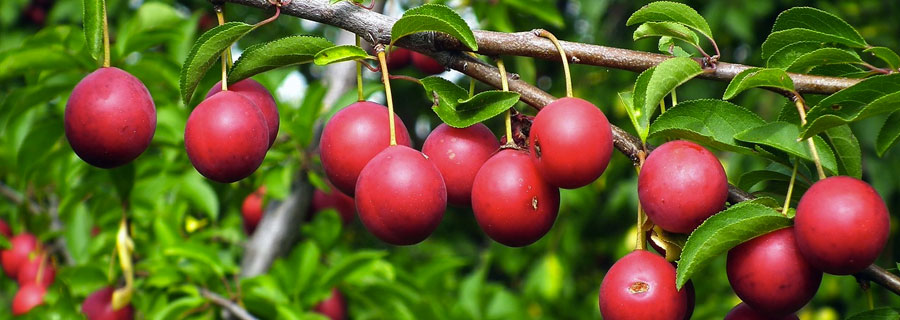Plum Tree Pruning: Getting the Timing Right
Younger plum trees are best pruned in spring and established trees in mid-summer
Expert insight into the best time to prune a plum tree; why you should prune a plum tree, and how to avoid the risk of spreading disease and harming the tree.
The plum tree is part of the family known as Prunus Domestica, which also produces damsons and greengages. Plum trees are not native to the United Kingdom but are still fairly common here. They do not grow very tall and are characterised by their straight branches and spiny twigs. There are numerous varieties of plum that can cross-pollinate easily and in doing so will produce fruits that differ in colour and sweetness.


Why prune a plum tree?
It is important to train a plum tree during its formative years, and to keep it well dead-wooded later in life. This will ensure good crops of fruit courtesy of a strong and healthy structure.
Old, overgrown plum trees can be brought back to their full glory through renovation. With good pruning over the course of a few years, an ageing plum tree can be rebalanced and go on to produce healthy crops of fruit.
Plum trees are well known for producing large crops of fruit. This can put a strain on the branches which will tend to break under the weight. Thinning is therefore vital to prevent damage to the tree.
So when is the best time to prune a plum tree?
When is the best time to prune a plum tree?
Contrary to most advice you will read about tree pruning and how it should be confined to the winter months when the tree is dormant, plum tree pruning should be carried out in early spring to mid-summer depending on the age of the tree. Younger trees are best pruned in spring and established trees in mid-summer.
Winter plum tree pruning should be avoided because it can leave the tree prone to infection by silver leaf disease. This is a fungal disease of the leaves and wood to which plum, apple, apricot and cherry trees are prone. The wounds caused by pruning can make the tree susceptible because they allow the fungus to penetrate the wood. The result is a silvering of the leaves followed by death of the branch.

There are four main methods used to prune a plum tree. Most common is the bush which produces an attractive result and strengthens the tree by removing weak and diseased shoots and branches. Pruning should be carried out in early spring with further thinning in July if required.
For smaller spaces, pyramid plums are the preferred choice. There is quite a particular process involved with this method. Newly planted plum trees should be pruned in April then, during the tree’s first summer, pruning should be carried out in the third week of July once the young shoots have completed their growth burst. In the years that follow, stick to April for pruning until the tree reaches 6-8 feet depending on the variety, then after that every May to maintain the height. Vertical shoots that are competing with the central leader should be removed in late June.
Fan and cordon training are the other two methods which again should be undertaken in spring.
Plum tree renovation should be carried out in the spring with any resulting vigorous growth thinned out in the summer.
Any dangerous branches that have broken under the strain of a fruit crop, or for any other reason, should be pruned back into undamaged wood, preferably without leaving stubs.
What to look for when pruning a plum tree
The plum tree is prone to a number of diseases and pests including silver leaf disease, bacterial canker, honey fungus, pocket plum, plum moth and plum aphids. Look out for small holes in leaves and sunken, dead patches of bark (bacterial canker); decaying roots, white fungus between wood and bark and sudden death (honey fungus); distorted, stone-less fruits (pocket plum); caterpillars inside fruit (plum moth) and sticky, severely distorted leaves with aphids on the undersides (plum aphids).
Tree Preservation Orders
Never go ahead with any tree work without first checking to see whether there is a Tree Preservation Order (TPO) in place. If there is then permission will be required for the works which can take up to eight weeks to come through. What’s more, if the tree is located in a conservation area, permission will be needed for any works.
The importance of plum tree pruning expertise
No matter what species of tree you are looking to prune, whether it is fruit bearing, ornamental, young or old, you should not even think about proceeding unless you have a good understanding of tree biology.
Inappropriate pruning can lead to devastating damage and may even shorten the tree’s lifespan. Plum tree pruning is a very particular craft, especially if you are looking to secure good crops of healthy fruit and keep the tree looking its very best year-round. For the best results, do not hesitate in calling in specialist, qualified assistance from a qualified tree surgeon.
If you have a plum tree on your land that needs pruning, why not talk to T.H. Tree Services? As fully qualified and highly experienced tree surgeons, we are able to offer expert knowledge and skill in all aspects of plum tree pruning. For a free, no-obligation quotation, give us a call on 01268 642814 or get in touch here.
Had a fallen tree in the early hours of Monday morning, called for quote and the team had it cleared on the same day. Really good communication when the lads were onsite and did a great job. Lots of pride in their work shown with the thorough clear up. Would thoroughly recommend.
Thank you Stuart for your kind review. We were glad to be able to help you with your fallen tree. If there's anything else you need in the future, please don't hesitate to get in touch.







